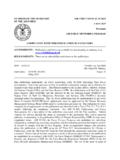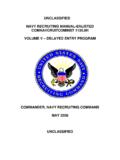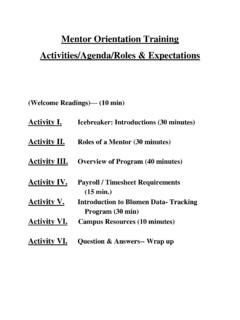Transcription of Peer Mentoring for the New Employee - Milt Wright
1 Copyright 2003 Milt Wright & Associates, Inc. (800) 626-3939 1 peer Mentoring for the New Employee Making a Difference One Employee At A Time Presented by Richard Pimentel Senior Partner, Milt Wright & Associates, Inc. The following materials are copyright excerpts from Developing the New Employee Mentoring is the history of business itself. At one time the one-on-one guidance of a wise master to his/her apprentice was the only way someone could learn a trade. A person did not go out and get a job he or she went out and recruited a mentor.
2 With the advent of the industrial revolution, businesses changed from small to large operations and mentors were replaced with managers, supervisors and training departments. The one-on-one guidance of a mentor was relegated to the up and coming employees who were being groomed to take rise to the top. This old boy network served its purpose well until minorities started coming into the workplace and it became obvious that those employees who had a mentor did better than those who did not, and minorities were far less likely to have a mentor than their non-minority counterpart.
3 Thus mentorship, which had become a well-understood but still unstructured corporate program, now became a structured Human Resources program for targeting women and minorities for success. Today businesses face an aging workforce, an impending labor shortage and a severe skill shortage. At one time, employers could hire people who knew how to be employees and how to do the job with little or no additional training. That has been sometime ago. Soon it became apparent that many employees knew how to be employees but did not have the skills to do the job.
4 Thus corporate skill training was born much to the unhappiness of supervisors who complained that they did not have the time to train people to do the job and supervise them too. However today we face another problem we know how to train new employees on how to do the job but we are now seeing more and more employees who simply do not know how to be an Employee . What do we do? Create a training program for at risk applicants to teach them how to be an Employee ? If not that then do we hire them and hope for the best?
5 The answer may be found in a new application of the oldest training peer Mentoring to be exact. The goal is to help the Employee to stay on the job long enough to learn the job. Mentoring this at risk population requires three things. 1. An understanding of the population to be mentored. 2. Training of the peer mentors. 3. Ongoing oversight by Human Resources for the entire process. Copyright 2003 Milt Wright & Associates, Inc. (800) 626-3939 2 BENEFITS OF Employee Mentoring By pairing up a new Employee with someone in the company who is more experienced to serve as an Employee coach or mentor, you will offer encouragement, promote growth and develop employees while helping them make a greater contribution to the organization.
6 Employee coaching and Mentoring can also help an already effective Employee become even more productive in his or her current position. Some of the benefits of implementing an Employee coaching or Mentoring process include: The mentor or coach can provide individual assistance to employees who encounter difficulties or who are experiencing the challenges of transition as new employees. The availability of a mentor or coach can empower the Employee and demonstrating the employer s commitment to that person s success.
7 The mentor or coach can help to establish a climate in which Employee personal and career growth can take place and create a safe place for employees to bring questions and problems. The mentor or coach can model appropriate business behaviors that you want to cultivate in the Employee . The mentor or coach can keep the Employee informed about opportunities where his/her skills dovetail with the company s goals and strategies. GUIDELINES FOR Employee Mentoring Mutually commit to the concept of coaching Acknowledge Employee potential and show appreciation Elicit cooperation and encourage Employee ideas Together, establish mutual goals and choose a course of action Provide positive reinforcement for improvement Hold periodic review meetings Place value (thus reward) on the Mentoring role Copyright 2003 Milt Wright & Associates, Inc.
8 (800) 626-3939 3 Employee BEHAVIOR CHECKLIST Source: This is an excerpt from Developing The New Employee Trainer s Manual, written by Richard Pimentel (1) _____ Following company rules and regulations. (2) _____ Showing up for work on time; calling in promptly when late or sick. (3) _____ Maintaining good personal hygiene and dressing appropriately. (4) _____ Exhibiting appropriate interpersonal behavior with coworkers and customers. (5) _____ Maintaining professional integrity in conflict situations and managing moods and emotions appropriately.
9 (6) _____ Being willing to speak up when there is a problem. (7) _____ Being able to respond well to constructive criticism and being able to give criticism in a constructive way. (8) _____ Treating coworkers with respect; not using inappropriate language in the workplace; not flirting with or teasing coworkers or telling racist or sexist jokes. (9) _____ Looking for ways to use time, skills and talents to the advantage of the organization; not waiting for someone else to tell them what to do but seeking ways to maintain productivity.
10 (10) _____ Maintaining performance standards. (11) _____ Being willing to share and give credit where credit is due. (12) _____ Being honest regarding compensation, hours worked, etc. (13) _____ Being loyal to the company in terms of not sharing product or service secrets or customers with competitors. (14) _____ Not lying, cheating or stealing from the company, one s coworkers or customers. (15) _____ Not drinking alcohol or using drugs during work hours; not coming to work having consumed alcohol or drugs.












